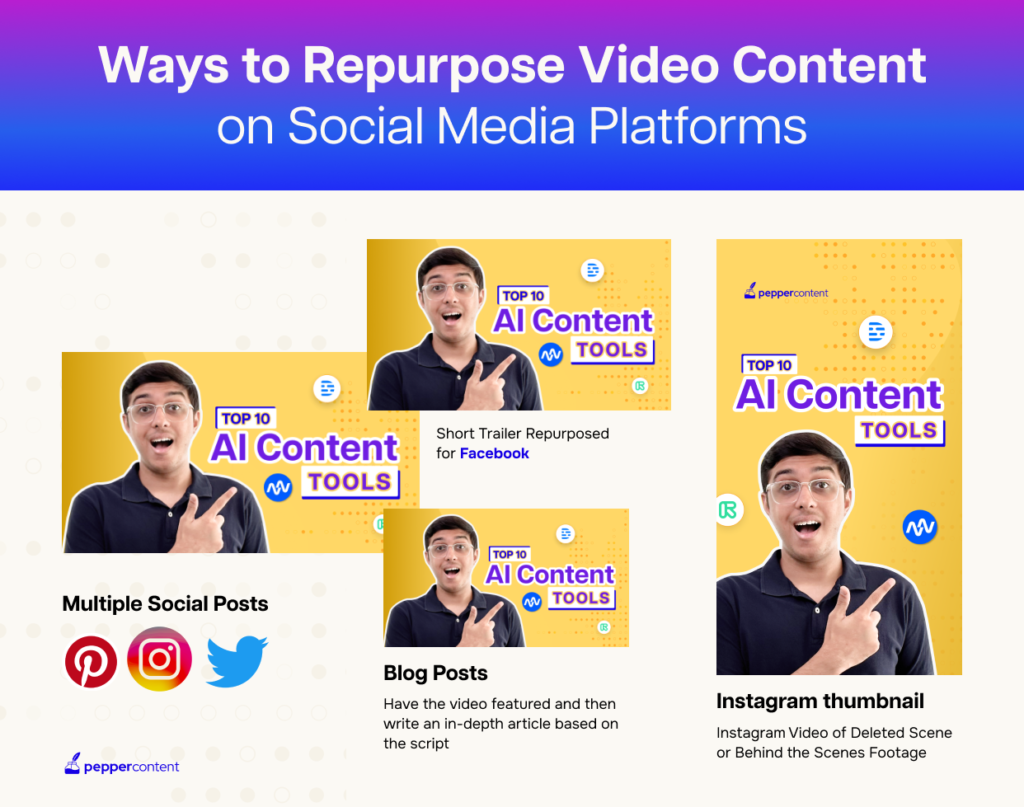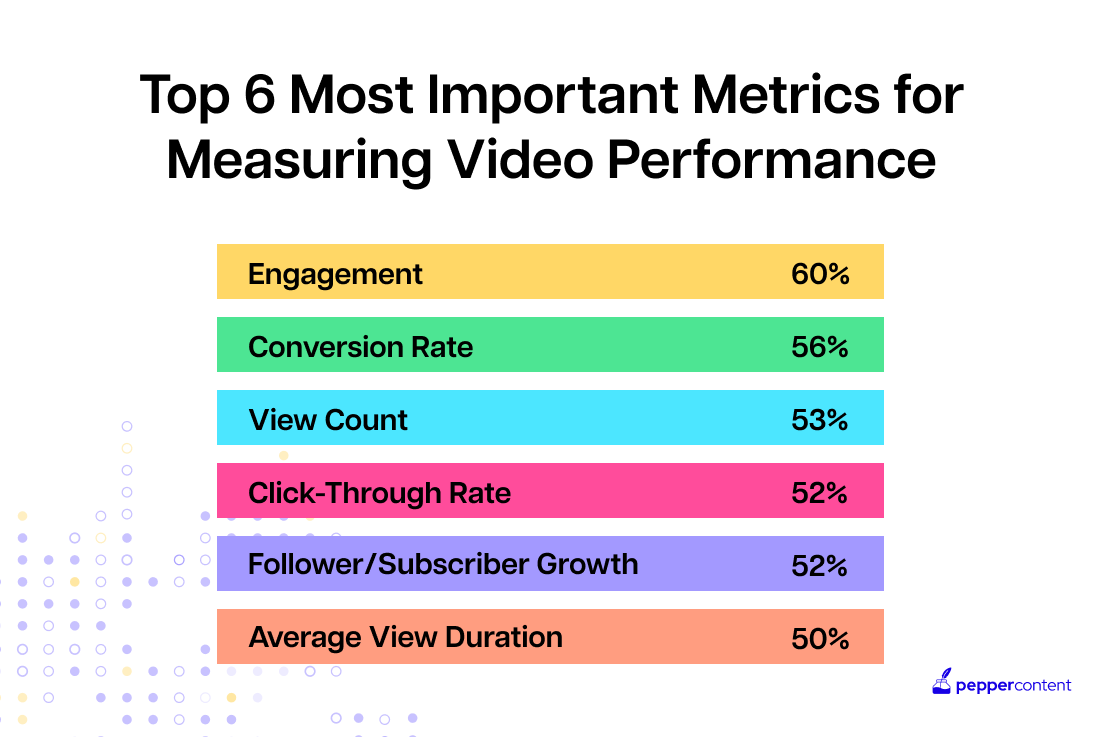How To Go About Extending The Lifespan And Value Of Your Videos With Video Content Repurposing

The rise of video in marketing has been nothing short of meteoric. With the advent of smartphones and faster internet speeds, people have become voracious consumers of video content. From cute cat videos to informative tutorials, videos have taken over our screens and captivated our attention.
With such a vast amount of video content available, marketers face a quality vs. quantity dilemma. It’s not enough to simply produce a high volume of videos; they must also stand out amongst the sea of competition. This is where video content repurposing comes into play.
Video repurposing involves transforming a piece of video content into various forms for use across multiple platforms. This process allows marketers to maximize their return on investment by extending the lifespan and value of their videos.
Video repurposing offers marketers the opportunity to maximize the ROI of their videos by extending their lifespan and value. By creatively transforming videos into different formats and targeting diverse platforms, brands can reach new audiences and make a lasting impact in the ever-evolving world of digital marketing.
Understanding Content Repurposing
Content repurposing is the key to unlocking the full potential of your video content. It involves transforming a piece of content into various forms that can be used across multiple platforms, amplifying its reach and impact. By creatively communicating your message through different formats and locations, you can expand your audience and maximize the value of your videos.
Successful brands like Coca-Cola have mastered the art of video repurposing. They have repurposed their TV commercials into short social media clips, allowing them to engage with their audience on different platforms. This strategy not only extends the lifespan of their videos but also ensures that their content stands out in a cluttered digital landscape.
Another example comes from Red Bull, who repurposed their extreme sports videos into podcast episodes. By repackaging their video content in an audio format, they were able to cater to a new audience who prefer consuming content while on the go. This approach allowed them to tap into the growing popularity of podcasts and reach listeners who may not be avid video watchers.
Repurposing videos into different formats offers immense opportunities for expanding your reach beyond YouTube fans or video lovers. It allows you to tap into different audiences who prefer consuming content in various ways. By adapting your videos to different platforms and formats, you can effectively engage with your target audience wherever they are.

Types of Video Content Repurposing
When it comes to repurposing video content, there are several creative ways to breathe new life into your existing videos. By transforming your videos into different formats, you can reach a wider audience and maximize the value of your content.
A. Transforming videos into blog posts or articles
Repurposing your videos as blog posts or articles allows you to tap into the power of written content. This type of repurposing is particularly effective when you have valuable information and insights to share. Take HubSpot, for example. They turn their webinar recordings into detailed blog posts with additional insights and takeaways, enabling them to reach a larger audience who prefers reading over watching videos.
B. Converting videos into podcasts or audio clips
Podcasts have gained immense popularity in recent years, making them an excellent platform to repurpose video content. TED Talks, known for their engaging conference presentations, created a podcast series by extracting the audio from their popular videos. By doing so, they expanded their reach beyond their YouTube fanbase and attracted new listeners who prefer consuming content on the go.
C. Creating social media graphics or snippets
Social media platforms provide the perfect opportunity to transform your videos into bite-sized content that is highly shareable. GoPro, famous for their action-packed videos, capitalized on the popularity of Instagram stories by creating captivating snippets from their videos. This allowed them to captivate their audience in a visually compelling way and drive engagement on social media.
By exploring these different types of video content repurposing, you can leverage the strengths of each platform and cater to different audience preferences. The key is to identify which formats align best with your target audience and ensure that your core message remains intact throughout the repurposing process.

Strategies for Effective Video Repurposing
Effective video repurposing requires careful consideration of your audience, the platforms you are targeting, and the core message you want to convey. Here are some strategies to make the most out of your video repurposing efforts.
A. Analyze your audience and choose appropriate platforms:
When you repurpose video content, it is crucial to understand your target audience and where they are most likely to consume content. Are they avid YouTube users, or do they spend more time on Facebook or Instagram? By identifying the platforms where your audience is most active, you can tailor your repurposed videos accordingly.
Take National Geographic as an example. They adapt their nature documentaries for the Nat Geo Kids YouTube channel, catering to a younger audience who may not typically watch their main TV channel. By doing so, they expand their reach and engage with an entirely new demographic.
B. Tailor content length and format for specific platforms:
Different platforms have different requirements when it comes to content length and format. To ensure maximum engagement, it is essential to adapt your videos accordingly.
Look at how Tasty repurposes their cooking videos into short, engaging recipe GIFs for social media platforms like Instagram and Twitter. By condensing their longer videos into bite-sized clips that provide quick recipes and visual inspiration, they cater to the fast-paced nature of these platforms and capture the attention of busy users scrolling through their feeds.
C. Repurpose with a purpose: Retain the core message while adapting to different formats:
While repurposing your videos, it is essential to retain the core message and value that your original video provided. However, you should also consider adapting the format to suit the platform and audience you are targeting.
IBM has successfully repurposed their technology-focused videos by transforming them into animated explainer videos. By simplifying complex concepts into visually appealing animations, IBM makes their content more accessible and easier to consume for a broader audience.
By analyzing your audience, selecting the appropriate platforms, tailoring content length and format, and repurposing with a clear purpose, you can effectively extend the lifespan and value of your video content. Remember, the key is to keep your core message intact while adapting it to fit different formats and platforms.
Tools and Resources for Video Content Repurposing
Video content repurposing can be a powerful strategy to extend the lifespan and value of your videos. But how do you repurpose video content effectively? Well, luckily, there are a variety of tools and resources that can help make the process easier and more efficient. Let’s take a look at some of these tools and see how they can assist you in repurposing your video content.
- Firstly, video editing software is essential for repurposing your videos. Programs like Adobe Premiere Pro provide a range of features that allow you to edit, enhance, and transform your videos into different formats. Whether you want to create shorter clips for social media or convert your videos into audio podcasts, video editing software gives you the flexibility to customize your content for various platforms.
- Another useful tool is Canva, an online graphic design platform. While Canva is primarily known for its graphic design capabilities, it also offers video editing features. This means you can easily create eye-catching social media graphics or snippets from your videos without needing to invest in expensive software or hire a professional designer.
- In addition to editing tools, transcription services can greatly aid in repurposing video content into written formats. Moz, for example, uses transcription services to turn their popular Whiteboard Friday videos into informative blog posts. By transcribing the spoken content of their videos, they can reach a wider audience who may prefer reading over watching videos.
Furthermore, transcription services also assist with search engine optimization (SEO). By providing written content alongside your videos, you increase the chances of your content being discovered by search engines and attracting more organic traffic.
Measuring Success and Adaptation
Tracking the success of your video content repurposing efforts is crucial to understanding what works best for your audience and making necessary adaptations. By monitoring key metrics across different platforms, you can gain valuable insights into the effectiveness of your strategy.
Measuring success is not just about numbers; it’s also about adapting and evolving your strategy based on the insights you gather. It requires a willingness to experiment, learn from your audience, and stay nimble in an ever-changing digital landscape.

The beauty of video content repurposing lies in its ability to expand your reach beyond YouTube fans or video lovers. By transforming your videos into different formats and sharing them on various platforms, you can engage with new audiences who may not have discovered your brand through traditional video channels.
But the benefits don’t end there. Repurposing your videos allows you to maximize your return on investment (ROI). Instead of creating new content from scratch every time, you can leverage existing videos and give them a new life. This not only saves time and resources but also ensures that your message reaches a wider audience.
So, as a content marketer, it’s time to embrace the power of video content repurposing. Start by analyzing your existing videos and identifying opportunities for repurposing. Consider the different formats and platforms that align with your target audience’s preferences.

Latest Blogs
Explore how Google’s 2025 AI search updates triggered ranking chaos. Learn actionable strategies to adapt your SEO for AI Overviews, zero-click searches, and SERP volatility. Stay ahead now.
Learn how to rank on AI search engines like ChatGPT, Perplexity, and Gemini by optimizing your content for authority, structure, and relevance. Stay ahead in AI-driven search with this strategic guide.
Explore the best healthcare SEO services for your medical practice. Improve online visibility and effectively reach more patients in need of your services.
Get your hands on the latest news!
Similar Posts

Content Strategy
5 mins read
Choosing The Best Healthcare Marketing Agency For Effective Content Solutions

Content Marketing
4 mins read
Top 10 Agencies B2B SaaS Content Marketing for B2B Success

B2C Marketing
5 mins read